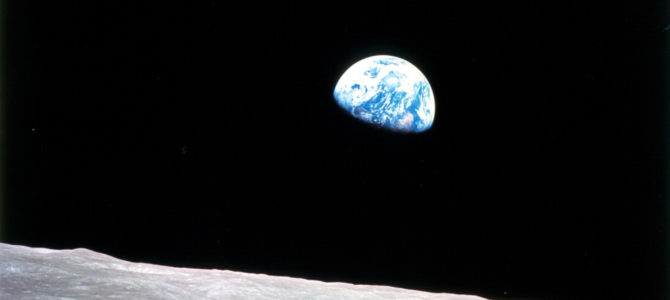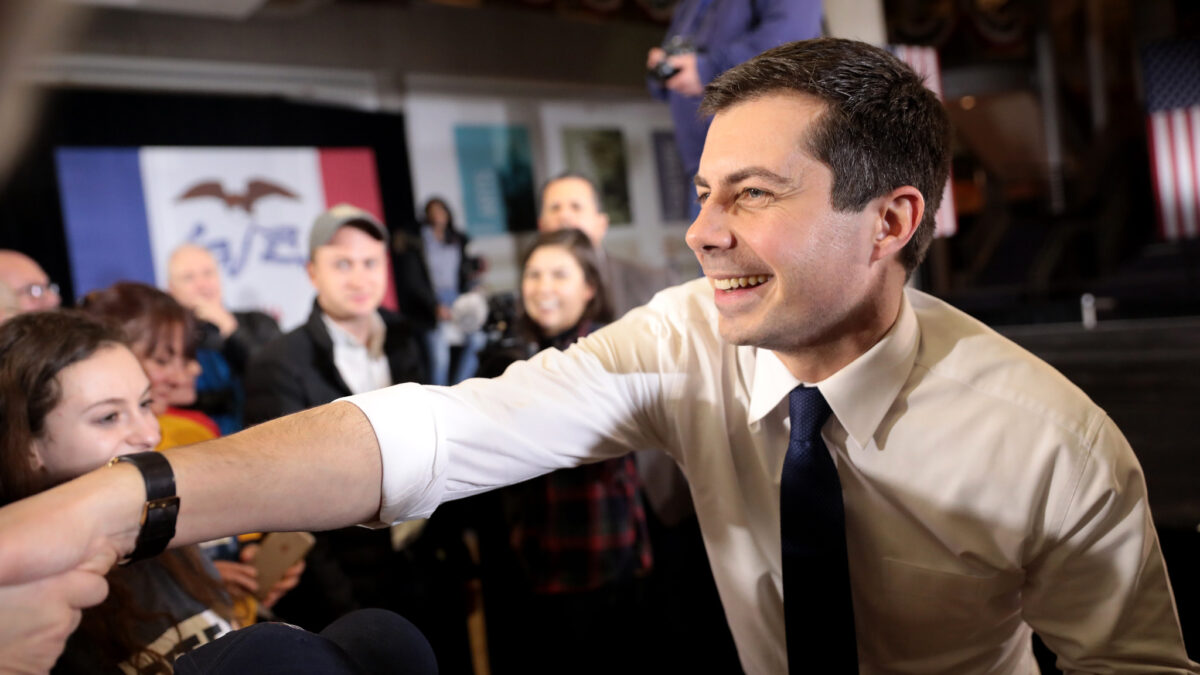
Many say Apollo 8 redeemed 1968. The first manned space mission to circle the Moon did so on Christmas Eve, and gave hope to weary millions jolted by the chaotic tumult of events in 1968.
The year that ended with the unifying wonder of Apollo 8 began with the aggressive attacks of the Tet Offensive in Vietnam in late January, followed by the assassinations of Martin Luther King Jr. in April and Robert F. Kennedy in June. Riots engulfed cities with fire and rage, and violent protests later that summer rocked the Democratic convention in Chicago, leading to a bitter, divisive presidential election that November.
The growing cascade of fury made it seem that everything was falling apart. But then, one bright hope crowned 1968: for the first time in history, humans flew around the Moon.
NASA’s Hard Year
The National Aeronautics and Space Administration (NASA) designated Apollo 8 as the mission to pioneer sending people to the Moon, but they planned it with great apprehension. Less than two years earlier, NASA had lost three astronauts during the Apollo 1 launch pad fire. Neither the public, nor Congress, would accept three more dead astronauts.
Had their extensive work fixed all of the problems? The new mission was far from a sure thing: Apollo 8 would be only the second human launch since the Apollo 1 fire; humans had not flown using the massive Saturn V rocket required to reach the Moon; the farthest humans had left Earth’s orbit was 850 miles, during the Gemini missions, as compared to the 240,000 miles necessary to reach the Moon’s orbit; during orbit, the spacecraft would periodically pass behind the Moon and lose contact with Earth; and if the engine failed to fire while trying to return to Earth, the crew would be forever trapped in space.
Susan Borman, wife of Apollo 8’s designated commander, Frank Borman, understood that Apollo 8 would be a pioneering mission to help achieve the dream of landing men on the Moon. However, she feared that her husband might pay the ultimate price during this mission. Susan went to Chris Kraft, the director of flight operations at what is now the Johnson Space Center, and asked if Frank was coming home this time. Kraft said plainly: Frank Borman had a 50/50 chance of coming home safely.
For Frank Borman, this mission was his last no matter what. He believed it was incredibly difficult for his family to have their husband and father in a rocket. He wanted nothing more than to live quietly with the dearest things in his life––his wife, his parents, and his kids.
However, Borman was also a career Air Force officer who wanted to beat the Soviets in the “space race.” In September of that year, the Soviets launched the Zond 5 mission, which consisted of a small spacecraft carrying two tortoises, mealworms, wine flies, and a few other living creatures. Zond 5 came within 1250 miles of the lunar surface and was able to come crashing back into the Indian Ocean with the animals alive.
This information confronted NASA with the possibility that the Russians had a plan to send humans to the Moon before NASA did. This pushed Borman to complete Apollo 8’s goals and, in his own words, “that’s the only thing that motivated me––beat the d-mn Russians.”
But there was one final catch. A Moon mission in December would have to take flight during the last ten days of the month––over Christmas, essentially––in order to adjust to the Moon’s orbit. Thus, to complete the mission, NASA would need help from the U.S. Navy.
The flight plan projected Apollo 8’s crew to land in the Pacific Ocean roughly two days after Christmas, but U.S. sailors had already received orders to stand down for the holidays. In other words, NASA would need ships to recover its astronauts, but those ships would be docked in Pearl Harbor. This meant that someone would have to convince the Navy to break up the shore leave of thousands of sailors.
That lucky individual was Kraft. The NASA flight director flew to Hawaii to meet with John McCain, Jr., the commander-in-chief of the Pacific Command and father of the future senator from Arizona, who had just entered his second year as a prisoner of war in Vietnam. Kraft hoped the opportunity to successfully send astronauts to the Moon and back would lift the admiral’s mood. He was deeply engulfed in directing naval forces fighting the Vietnam War.
Kraft presented his request to a conference room filled with Navy captains and admirals, with Admiral McCain smoking a cigar, sitting in the middle of the front row. After a thorough presentation, Kraft got to the point: NASA needed ships at sea throughout the Apollo 8 mission, and without the Navy’s help, the communists might win the space race.
At first, there was silence, but then, as Kraft recalls, McCain stood up and threw his cigar down on a table and said, “That’s the best g-dd-mn briefing I’ve ever heard, give this young man anything he wants.” NASA was going to the Moon.
Apollo 8 launched on December 21, 1968, without mishap, becoming the first manned spacecraft to leave Earth’s orbit and fly to the Moon. Within two minutes of the Apollo 8 launch, the crew had eclipsed the record for farthest distance that humans ever ventured from Earth. Now came the long, three-day flight to the Moon. Everything went according to plan.
While orbiting the moon, the Apollo 8 crew fulfilled their mission objectives to take pictures of lunar craters and locations of future landing sites, but something fascinated the three men even more: the Earth. The dearest things in their life were back on that jewel-like blue planet, contrasted even more beautifully against the beaten up, sandblasted ball that was the Moon.
It was that moment, with Earth coming up over the lunar horizon, where all three astronauts clamored for cameras to capture a shot of their home. As Bill Anders, the crew member who took the now-famous Earthrise photo recalls it, “We came all this way to explore the Moon, and the most important thing is that we discovered the Earth.”
The Best Part of the Mission
Already shattering records, the crew prepared for what became the highlight of the mission: a live television broadcast on Christmas Eve while circling the Moon. NASA reports that an estimated 1 billion people in 64 countries watched the broadcast live, and people in an additional 30 nations watched the broadcast that same day.
The only instruction they received from NASA was “to do something appropriate.” The Apollo 8 crew had a difficult time deciding what to do for this historic broadcast, scrapping such ideas as reading “The Night Before Christmas” or “Jingle Bells.” A mutual friend of all three crewmembers knew a newspaper reporter, so they asked him for help.
Apparently, that reporter spent one night trying to figure out what to write, and his wife came down the stairs and asked, “What are you doing?” He told her he was writing for the Apollo 8 crew and had nothing. His wife responded, “Well, you know, that’s simple––why don’t they read from the Old Testament, the first 10 verses of Genesis? I mean, it’s an emotional time, sort of a holy time, but Genesis, the first 10 verses, is the structure of most of the world’s religions––especially Christianity, but Judaism and also Islam.” So that’s exactly what they did.
On Christmas Eve, hundreds of millions across the globe gathered around their televisions to see the stark gray surface of the Moon rolling beneath Apollo 8, as the astronauts took turns reading the familiar words of the creation account: “In the beginning, God created the heavens and the earth…”
Back on Earth, as scenes from the Moon and the words from Genesis came down, many in Mission Control felt an immense emotional reaction. Rod Loe, a flight controller at the time, recalled having tears welling in his eyes. Chester Vaughn, a NASA engineer who had given a decade of his life to building spacecraft for this very purpose, recalled having goosebumps and thinking it was the best Christmas ever. Another observer, a young teenager from the Midwest, said he felt a deep sense of vast and profound awe as he watched the broadcast, connecting us to eternal truths greater than ourselves.
But uncertainty, even danger, remained. NASA would lose radio signal with the crew on the far side of the moon, right before the state-of-the-art engine needed to fire. This was the first time in history this would ever happen, and no one knew what to expect. It was out of Mission Control’s hands, so all they could do was hope and pray.
For agonizing minutes, there was nothing but complete silence at Mission Control. Then, the voice of astronaut James Lovell (later to command the ill-fated Apollo 13 mission) radioed down: “Houston, Apollo 8, over.” After Mission Control responded, Lovell radioed again, “Please be informed there IS a Santa Claus.” Mission Control burst into celebration.
Just two days later, the astronauts splashed down in the Pacific Ocean, secured by the USS Yorktown aircraft carrier. The jubilant world celebrated. With all that had occurred in 1968, the effect of Apollo 8 is best summed up by a famous telegram from an anonymous stranger, received by astronaut Borman after the mission, which simply stated, “Thank You Apollo 8. You saved 1968.”
Not all saw the glory of the moment. Madalyn Murray O’Hair, an activist who promoted atheism, filed a lawsuit against NASA, claiming the reading of Genesis in a government-owned capsule violated the Establishment Clause, the separation of church and “space.” She sought an injunction to stop any future religious-based statements by astronauts. The courts quickly dismissed the lawsuit, which sadly missed the bigger accomplishment of the Apollo 8 mission––the televised orbit around the Moon while reading Genesis brought us together to marvel at great truths that unite us.
The Apollo 8 crewmembers were selected as Time’s Men of the Year for 1968, recognizing them as the people who most influenced events in that year. All three astronauts were eventually inducted into the International Aerospace Hall of Fame. What became even more famous was the amazing Earthrise photo taken by the astronauts. The U.S. Postal Service issued a postage stamp commemorating the Apollo 8 flight around the Moon. The stamp featured the famous Earthrise photograph over the Moon taken on Christmas Eve, and included the words, “In the Beginning God…”
So, on this fiftieth anniversary of the Apollo 8 mission, Frank Borman’s concluding words of the Christmas Eve broadcast united and inspire us still today: “Good night, good luck, a merry Christmas, and God bless all of you—all of you on the good earth.”









